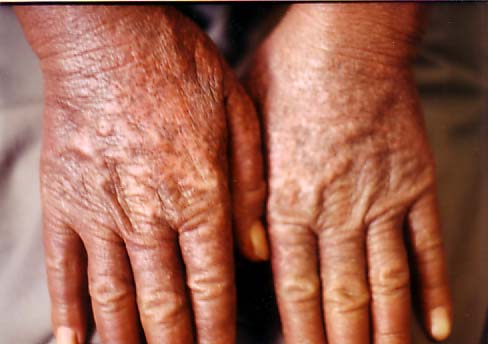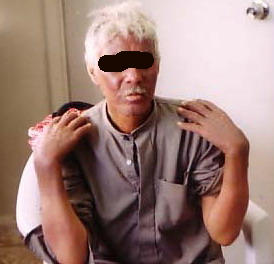

Case : pellagra
50-year
–old – male had a hyperpegmintation on the face, and dorsum of the hand ,
the skin is like scleroderma . diarrhea , and fatigue . his weight 48 kg . his
food tea and some bread .
Pellagra results from a
tissue deficiency of niacin (nicotinic acid) or its
precursor, the essential amino acid tryptophan. The condition is most common where
1- maize is the staple diet
2- chronic alcoholism
3- gastrointestinal disease in children
4- Pellagra-like reactions can also occur with isoniazid therapy and in the carcinoid syndrome with hepatic metastases
Besides the dermatosis, there are important gastrointestinal and,nervous system changes. Pellagra is characterized by the “three Ds”:dermatitis, diarrhea, and dementia ,and some authors said " four Ds":dermatitis, diarrhea, dementia , and death
pathognomonic, and their
distribution is determined especially by exposureto the sun and by localized pressure. The diagnosis of pellagra is difficult in
the absence of the dermatosis, which begins as erythema on the dorsa of
the hands, with pruritus and burning. It is characteristically symmetric with
slight edema of the skin. In some patients, several days after the onset of
the erythema, blisters appear; these run together to form bullae and then
break. In others, dry brown scales form. On the face, the scales are thicker,larger, and frequently become pustular.
In the second stage, the dermatosis becomes hard, rough, cracked,blackish, and brittle. The epidermis of the fingers thickens, and the articularfolds disappear. Painful fissures develop in the palms and on the digits. The
skin may look like that of a goose; hence the term goose skin. When the
deficiency state is far advanced, the skin becomes progressively harder,drier, more cracked, and covered with scales and blackish crusts that are
due to hemorrhages.
The usual sites are the face and neck and dorsal surfaces of the hands,arms, and feet. The changes are rarely seen elsewhere. The dorsa of the
hands are the most frequent site; here the lesions may extend up the
arms to form the “glove” or “gauntlet” of pellagra.
On the face the symmetry of the lesions is striking. They tend to spread from the sides to the rest of the nose, the forehead, cheeks, chin, lips,and, more rarely, eyelids and ears. The “butterfly” appearance, common to lupus erythematosus, is frequent. On the forehead there is always a narrow border of normal skin between the erythema and the hair
Casal's “necklace” extends as a fairly broad band, or collar, entirely around the neck
Treatment nicotinamid100mg/day